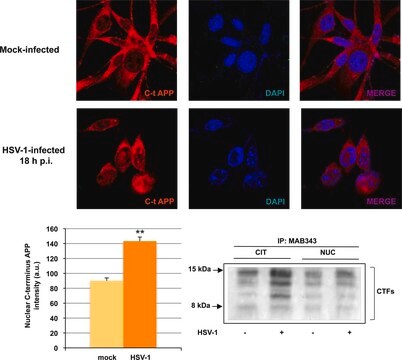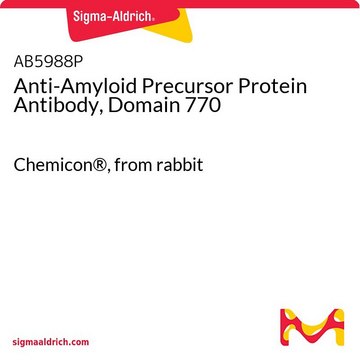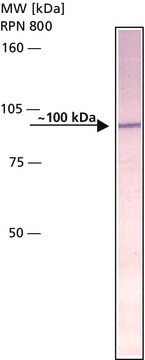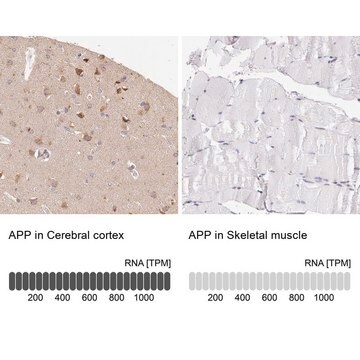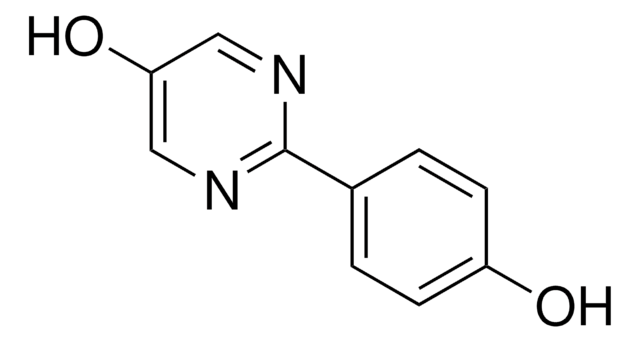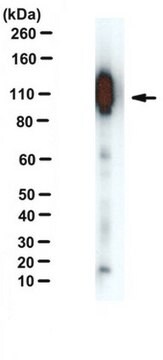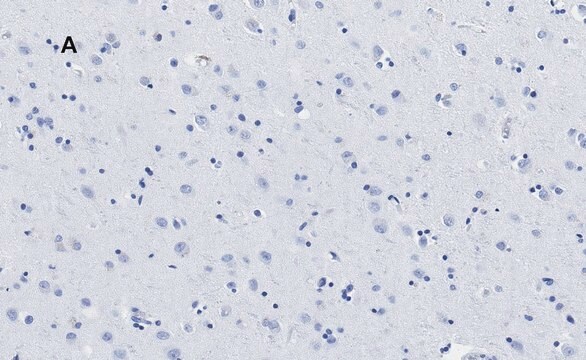MAB343-C
Anti-Amyloid Precursor Protein (APP) Antibody
mouse monoclonal, 2.F2.19B4
Synonym(s):
Amyloid beta A4 protein, ABPP, Alzheimer disease amyloid protein, Amyloid precursor protein, APP, APPI, Cerebral vascular amyloid peptide, CVAP, PN-II, PreA4, Protease nexin-II
About This Item
Recommended Products
Product Name
Anti-APP Antibody, CT, clone 2.F2.19B4, Ascites Free, clone 2.F2.19B4, from mouse
biological source
mouse
Quality Level
antibody form
purified immunoglobulin
antibody product type
primary antibodies
clone
2.F2.19B4, monoclonal
species reactivity
human, mouse
technique(s)
affinity binding assay: suitable
immunocytochemistry: suitable
immunofluorescence: suitable
immunohistochemistry: suitable (paraffin)
immunoprecipitation (IP): suitable
western blot: suitable
isotype
IgG1κ
NCBI accession no.
UniProt accession no.
shipped in
wet ice
target post-translational modification
unmodified
Gene Information
human ... APP(351)
General description
Specificity
Immunogen
Application
Immunocytochemistry Analysis: A representative lot immunostained neural progenitor cells (NPCs) isolated from the lateral ventricles of E14 mouse brain by fluorescent immunocytochemistry (Ma, Q.H., et al. (2008). Nat. Cell Biol. 10(3):283-294).
Immunoprecipitation Analysis: A representative lot immunoprecipitated APP and cleaved APP C-terminal fragments from uninfected and HSV-1-infected SH-SY5Y cells (De Chiara, G., et al. (2010). PLoS One. 5(11):e13989).
Western Blotting Analysis: A representative lot detected APP and cleaved APP C-terminal fragments in lysates and APP immunoprecipitates from uninfected and HSV-1-infected SH-SY5Y cells (De Chiara, G., et al. (2010). PLoS One. 5(11):e13989).
Western Blotting Analysis: Representative lots detected the stably expressed full-length human APP695 in HEK293-derived BA-3 cells (Hwang, E.M., et al. (2008). Bioorg. Med. Chem. 16(14):6669-6674; Yeon, S.W., et al. (2007). Peptides. 28(4):838-844).
Immunofluorescence Analysis: A representative lot immunostained the walls of the lateral ventricles in E14 mouse brain tissue sections by fluorescent immunohistochemistry (Ma, Q.H., et al. (2008). Nat. Cell Biol. 10(3):283-294).
Affinity Binding Assay Analysis: A representative lot captured the synthetic peptide representing APP770 a.a. 732-751 or APP695 a.a. 657-676 (Van Vickle, G.D., et al. (2007). Biochemistry. 46(36):10317-10327).
Neuroscience
Neurodegenerative Diseases
Quality
Immunohistochemistry Analysis: A 1:50 dilution from a representative lot detected APP immunoreactivity in normal human cerebral cortex and Alzheimer′s diseased (AD) brain tissue sections.
Target description
Physical form
Storage and Stability
Other Notes
Disclaimer
Not finding the right product?
Try our Product Selector Tool.
recommended
Storage Class Code
12 - Non Combustible Liquids
WGK
WGK 1
Flash Point(F)
Not applicable
Flash Point(C)
Not applicable
Certificates of Analysis (COA)
Search for Certificates of Analysis (COA) by entering the products Lot/Batch Number. Lot and Batch Numbers can be found on a product’s label following the words ‘Lot’ or ‘Batch’.
Already Own This Product?
Find documentation for the products that you have recently purchased in the Document Library.
Our team of scientists has experience in all areas of research including Life Science, Material Science, Chemical Synthesis, Chromatography, Analytical and many others.
Contact Technical Service
